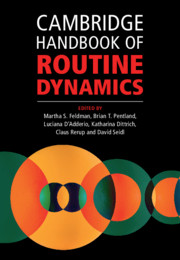Book contents
- Cambridge Handbook of Routine Dynamics
- Cambridge Handbook of Routine Dynamics
- Copyright page
- Contents
- Figures
- Tables
- Contributors
- Preface
- Chapter 1 What Is Routine Dynamics?
- Part I Theoretical Resources for Routine Dynamics Research
- Part II Methodological Issues in Routine Dynamics Research
- Part III Themes in Routine Dynamics Research
- Part IV Related Communities of Thought
- Chapter 33 Carnegie School Experiential Learning and Routine Dynamics
- Chapter 34 Dynamic Capabilities and Routine Dynamics
- Chapter 35 Strategy as Practice and Routine Dynamics
- Chapter 36 Path Dependence and Routine Dynamics
- Chapter 37 Business Process Management and Routine Dynamics
- Author Index
- Subject Index
- References
Chapter 33 - Carnegie School Experiential Learning and Routine Dynamics
from Part IV - Related Communities of Thought
Published online by Cambridge University Press: 11 December 2021
- Cambridge Handbook of Routine Dynamics
- Cambridge Handbook of Routine Dynamics
- Copyright page
- Contents
- Figures
- Tables
- Contributors
- Preface
- Chapter 1 What Is Routine Dynamics?
- Part I Theoretical Resources for Routine Dynamics Research
- Part II Methodological Issues in Routine Dynamics Research
- Part III Themes in Routine Dynamics Research
- Part IV Related Communities of Thought
- Chapter 33 Carnegie School Experiential Learning and Routine Dynamics
- Chapter 34 Dynamic Capabilities and Routine Dynamics
- Chapter 35 Strategy as Practice and Routine Dynamics
- Chapter 36 Path Dependence and Routine Dynamics
- Chapter 37 Business Process Management and Routine Dynamics
- Author Index
- Subject Index
- References
Summary
Given the centrality of experiential learning in the Carnegie School, we focus on how this form of learning provides an opportunity for deepening the relationship between the Carnegie School and Routine Dynamics. Experiential learning is central to Routine Dynamics because the flow and progression of routines emerge from experiential learning like processes of taking action, evaluating the results of those actions, and, if necessary, making adjustments to future actions.
Keywords
- Type
- Chapter
- Information
- Cambridge Handbook of Routine Dynamics , pp. 445 - 459Publisher: Cambridge University PressPrint publication year: 2021
References
- 4
- Cited by

